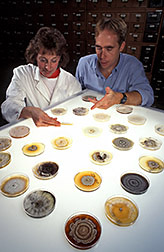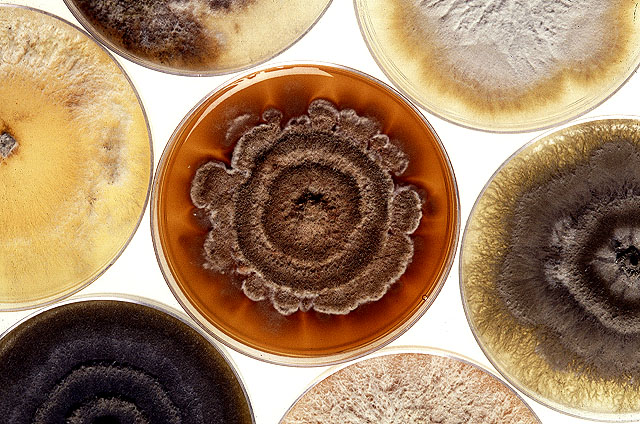Phomopsis Eludes Positive I.D.—Until Now
|
|
Information helps control fungus when it changes to a pathogen.
A destructive mold called Phomopsis attacks many vegetables and fruits—crops like soybeans, citrus, blueberries, apples, and cucumbers.
Most of the time, the fungus is quiescent and causes no visible harm to plant hosts. But under the right conditions, it can become a devastating pathogen.
"Phomopsis-related losses in U.S. soybeans alone are huge," says plant pathologist Martin M. Kulik, who is with the ARS Soybean and Alfalfa Research Laboratory at the Beltsville (Maryland) Agricultural Research Center (BARC).
According to Plant Disease journal, the soybean losses from 1989 to 1991 in 10 north-central states totaled over $104 million, while those for 16 southern states totaled $473 million.
"Surprisingly," says Steve Rehner, "we've found that 30 to 40 percent of plants have Phomopsis—as well as numerous other fungi and microorganisms—in their tissue."
A mycologist with the Systematic Botany and Mycology Laboratory at BARC, Rehner says Phomopsis can become pathogenic when humans inadvertently create conditions that trigger the fungus to cause disease.
"The key to Phomopsis control," he says, "is to better understand its role in nature."
|
|
But scientists searching for clues as to what stimulates the fungus to become virulent have been stumped by its occurrence on so many plant hosts.
"Phomopsis species have such a simple form and structure, or morphology, they are difficult to define," Rehner says. "Because many disease-causing fungi are host-specific, we have tended to describe Phomopsis species by the hosts they attack."
For the last 2 years, he has worked with former ARS mycologist Bud Uecker, a world expert on Phomopsis, to solve the problem.
Uecker catalogued and curated an extensive collection of over 400 strains of Phomopsis from a variety of plant hosts in North America and the Caribbean. His collection has become part of the 1 million specimens in the Smithsonian-ARS National Fungus Collections maintained at BARC.
Uecker summarized the systematics of this genus in a book that included reference to over 900 known species. After examining the morphology and characteristics of many strains, he concluded that trying to distinguish among species of Phomopsis based on morphology may be impossible.
Enter Rehner, an expert in DNA sequencing. After he and Uecker compared the DNA sequences and fingerprints of the 43 representative strains in the collection, they came up with a new hypothesis.
"Our results showed that isolates group together, even though they occur on different plant hosts—disproving the traditional view that host specificity is a unique feature of Phomopsis species," Raina says. "Rather, various species of Phomopsis may be found on many different hosts."
In fact, some species have an extremely broad host range—a discovery of major significance to federal and state plant quarantine officials who must check the health of plant materials coming into and leaving the country.
"Now, we're developing a combined approach," says Rehner. "It uses both molecular and morphological characteristics to define a set of attributes to identify individual species and to differentiate among them. This is a giant step toward controlling the fungus.
"This approach," he says, "can be used to differentiate species among other morphologically simple fungi—many of which can be plant pathogens. This will allow us to understand how these crop pathogens are related to fungal species infecting noncrop plants near farms." — By Hank Becker, ARS.
USDA-ARS Systematic Botany and Mycology Laboratory, Bldg. 011A, BARC-West, 10300 Baltimore Ave., Beltsville, MD 20705-2305; phone (301) 504-5364.








